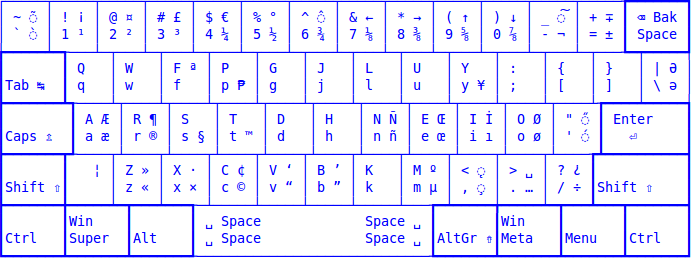
Philippines Unicode Keyboard Layout
Welcome to the official page for the Ubuntu Philippines LoCo Team project Philippines Unicode Keyboard Layout. Everything that has to do with the PH-UKL project will be posted here, from How-To’s to downloading to installing and setting up your machine so you can start using the keyboard layout.
Our first release is for the Filipino Linux Community all over the world. The second release for all Windows users. To download and install PH-UKL for your OS, just follow one of the links below:
- GNU/Linux (released on: 2010-10-23)
- Microsoft® Windows (released on: 2010-10-25)
- Mac OS X (more info)
- Windows 8 and 10 (more info)
Official source repository: https://codeberg.org/yelosan/unicode-keyboard-layout-philippines. If you have suggestions or bugs to report, please do not hesitate to file a ticket here.
QWERTY (Baybayin)
To the extent possible under law, I'M YourOnly.One has waived all copyright and related or neighbouring rights to QWERTY (Baybayin). This work is published from Philippines.
QWERTY (Latin)
To the extent possible under law, I'M YourOnly.One has waived all copyright and related or neighbouring rights to QWERTY (Latin). This work is published from Philippines.
Capewell-Dvorak (Baybayin)
To the extent possible under law, I'M YourOnly.One has waived all copyright and related or neighbouring rights to Capewell-Dvorak (Baybayin). This work is published from Philippines.
Capewell-Dvorak (Latin)
To the extent possible under law, I'M YourOnly.One has waived all copyright and related or neighbouring rights to Capewell-Dvorak (Latin). This work is published from Philippines.
Capewell-QWERF 2006 (Baybayin)
To the extent possible under law, I'M YourOnly.One has waived all copyright and related or neighbouring rights to Capewell-QWERF 2006 (Baybayin). This work is published from Philippines.
Capewell-QWERF 2006 (Latin)
To the extent possible under law, I'M YourOnly.One has waived all copyright and related or neighbouring rights to Capewell-QWERF 2006 (Latin). This work is published from Philippines.
Colemak (Baybayin)
To the extent possible under law, I'M YourOnly.One has waived all copyright and related or neighbouring rights to Colemak (Baybayin). This work is published from Philippines.
Colemak (Latin)
To the extent possible under law, I'M YourOnly.One has waived all copyright and related or neighbouring rights to Colemak (Latin). This work is published from Philippines.
The Philippines Unicode Keyboard Layout is a project of Ubuntu Philippines LoCo Team.

Philippines Unicode Keyboard Layout for Windows is out!
I finished the port of the Philippines Unicode Keyboard Layout for Linux to Windows much earlier than I hoped! Rejoice Microsoft® Windows users!
Get it now and start typing all the Filipino characters!

Philippines Unicode Keyboard Layout for Linux is now available!
Today, 23rd of October 2010, Filipino Linux users around the world can now download and use the first release of the Philippines Unicode Keyboard Layout, officially launched during the Philippines Ubuntu 10.10 Maverick Meerkat Release Party.
What is this all about? Simple: being able to type the characters that Filipinos use, especially the ₱eso sign and ᜊᜌ᜔ᜊᜌᜒᜈ᜔ (Baybayin) glyphs that has been available for use since Unicode 3.2 (March 2002). Other characters are: Ññ, ©, ®, ™, ¢, ¥, ¶, Pahilís (acute diacritic), Paiwà (grave diacritic), Pakupyâ (circumflex diacritic), Ng̃ (the shortened form of nan͠g), and many more.
How about Windows users? You will have to wait more or less 2 weeks, it will be usable for Windows 7, Vista, and XP; both 64-bit and 32-bit installations. It is now available for download.
Without further ado, here are the steps to get you started with using our very own Unicode Keyboard Layout.

The YOOki Chronicles is Yohan Yukiya Sese-Cuneta’s return into casual and personal blogging. The name “YOOki” is a mash-up of the acronym of YourOnly.One and my nickname ᜌᜓᜃᜒ (Yuki・雪矢).
Interestingly, according to Chinese legend,
.1柳
(YOO) is an ancient Chinese surname. The ancestors of the surname were closely linked with the ancient sage-king named Yu Shun. In Korea, the 유
(YU) lineage traces to the Xia, Han, and Joseon dynasties. Holders of the surname Yu or Yoo had a reputation for charity and diligence
It is also the word for “willow” or the “willow tree” which means graceful or slender; and a tree growing near a body of water which provide continuous nourishment and resources for everyone. It can also mean to exist, an oil (anointment(?)), and simply as “U” (you).
The Hanzi 紀
(ki) character means to record, be disciplined, provide order. While the Hangeul equivalent, 키
(ki), means energy, spirit, a banner, and a period of time; and is also a suffix used to make a gerund or an infinitive.








